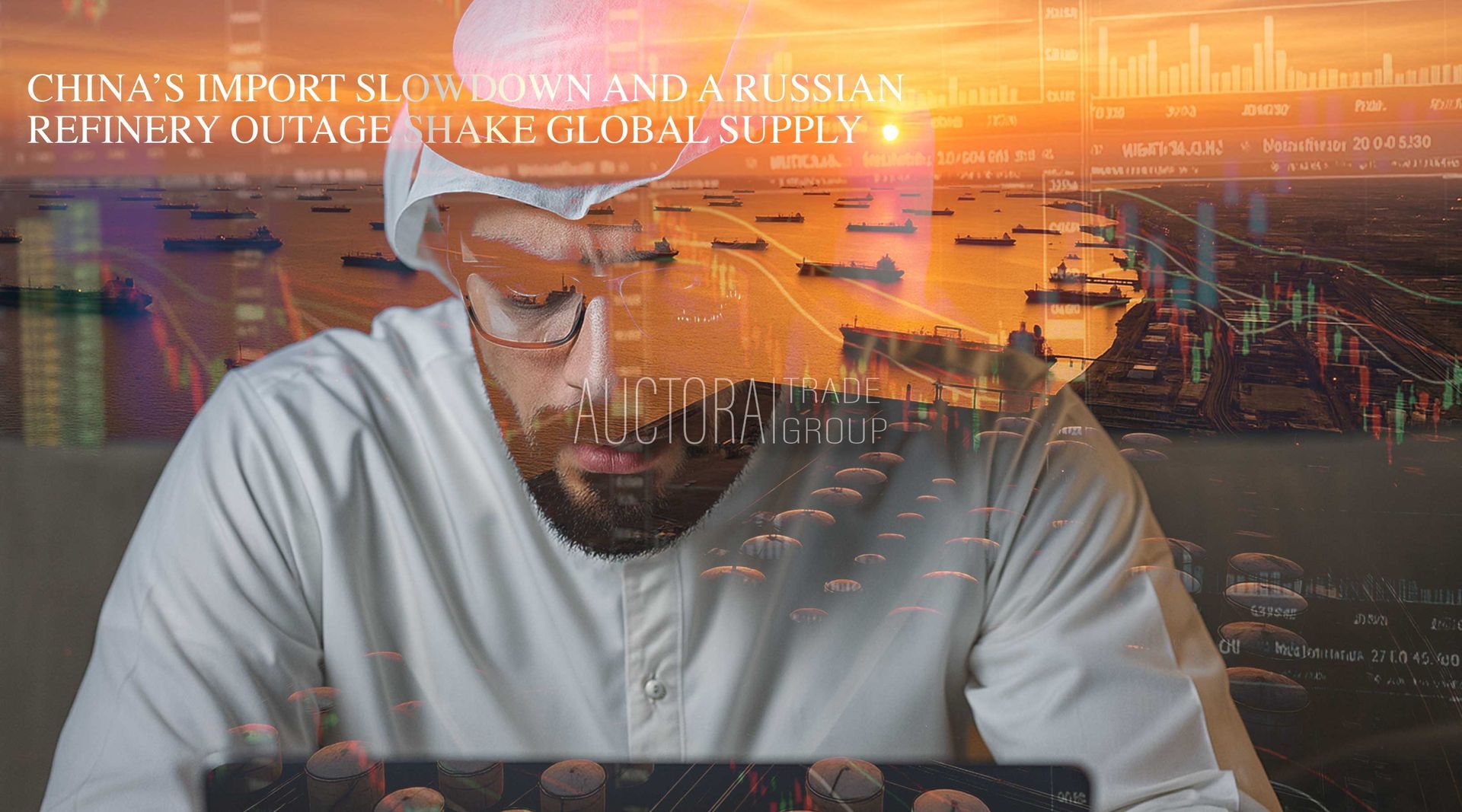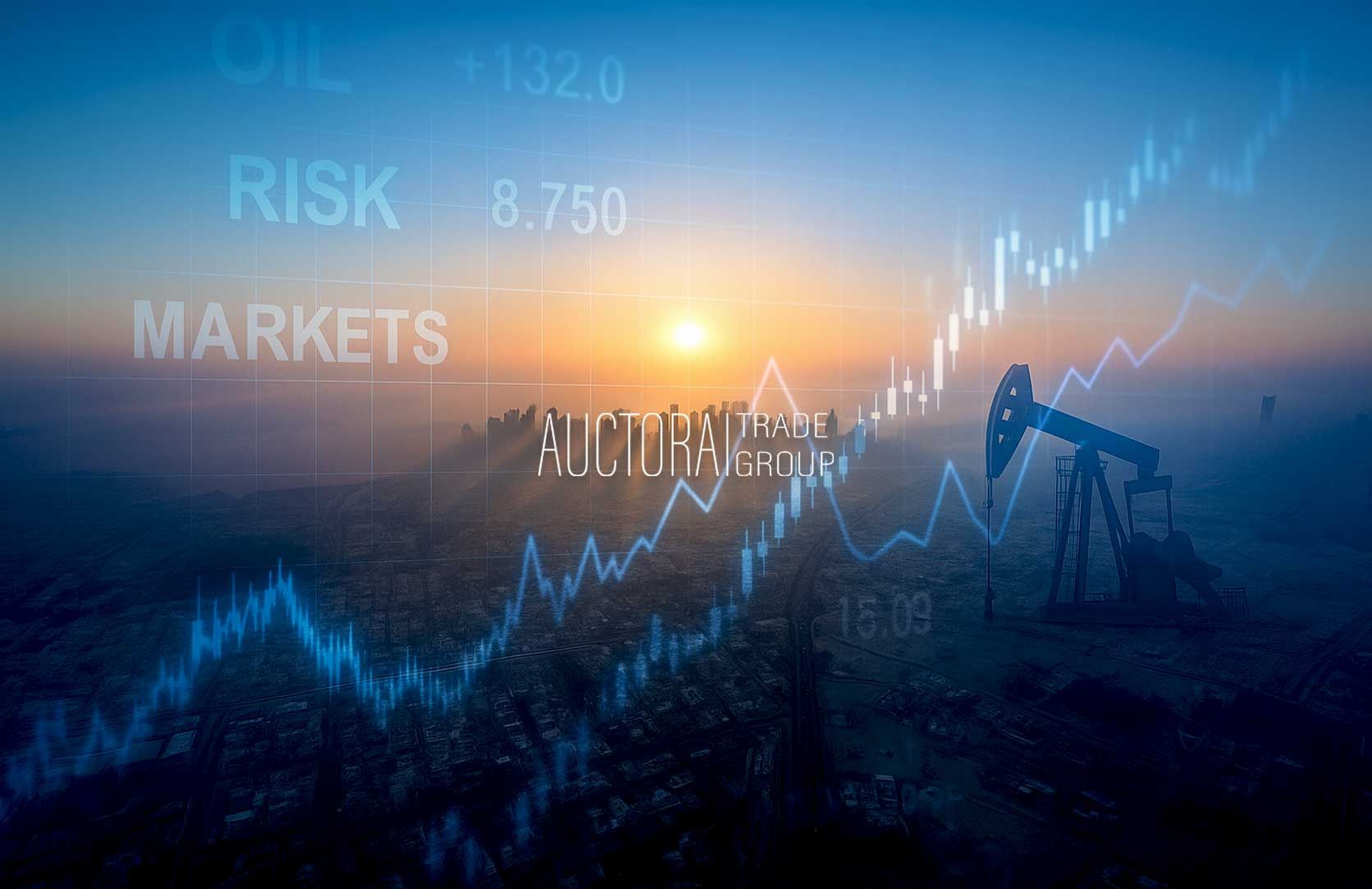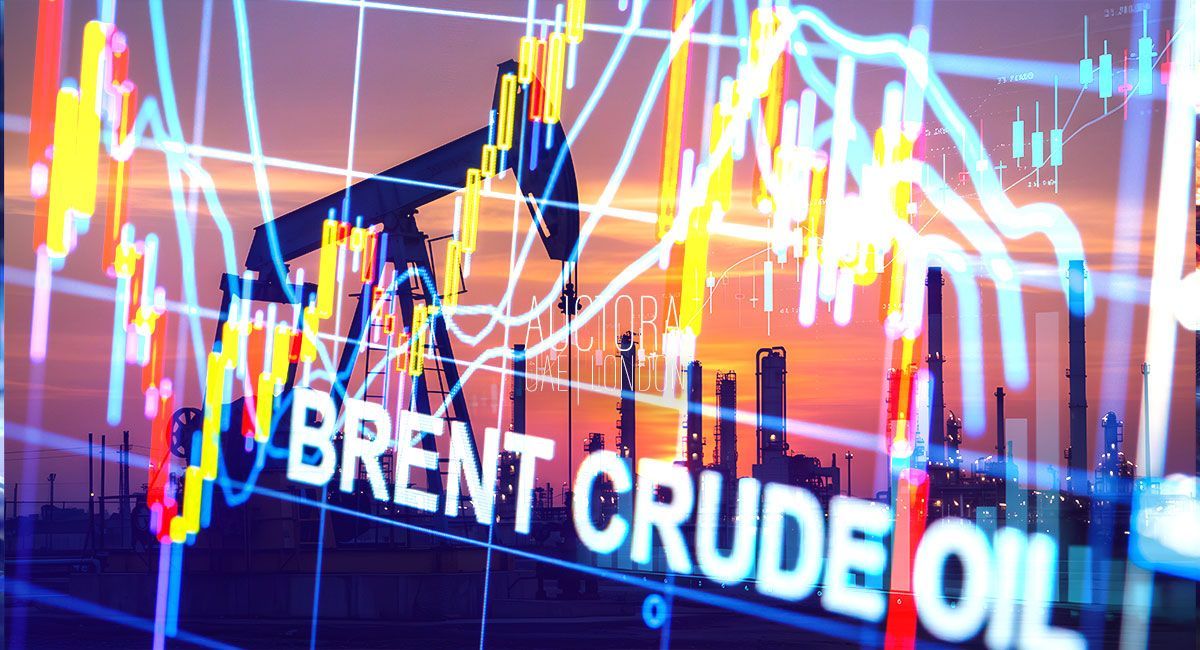Haberler ve Güncellemeler

IEA Surplus Warning, China’s Import Slowdown and a Russian Refinery Outage Shake Global Supply Published in Abu Dhabi, 20 October 2025 2:56pm (GST) Over the past week oil traders have been pulled between two very different narratives. On one side, fears of a deep oversupply have dragged Brent and WTI to multi‑week lows, with benchmarks down more than two percent last week and early trades this week seeing Brent futures around US$61.11 and WTI near US$57.34 as investors priced in a looming glut. On the other side, geopolitical flashpoints continue to crop up, briefly tightening supply and reminding the market that refined products and crude flows can be interrupted without warning. At Auctora we see opportunity in the dislocation between these themes – but only for buyers and sellers prepared to adjust strategies quickly. The oversupply narrative gains momentum The International Energy Agency’s latest market update raised its forecast for global supply growth and warned that the world could be staring at a major surplus as soon as 2026. Analysts now expect non‑OPEC production to grow faster than demand, driven by the United States, Brazil and Guyana. At the same time, OPEC+ has been unwinding some of its output cuts, reversing course after nearly two years of restraint to regain market share from U.S. shale and other rivals. The Gaza ceasefire has further reduced concerns about supply disruption in the Middle Eastoilprice.com. Combined with an easing of U.S.–China trade tensions, these factors have encouraged selling pressure and pushed prices lower.

Energy markets brace for volatility as Fed cuts ripple through oil, trade routes, and global investment flows. Published in London, 22 September 2025 12:26am (BST) The oil market has taken investors on a roller‑coaster ride since the U.S. Federal Reserve cut rates by 25 basis points on 18 September. Initially traders hoped that cheaper borrowing would spur demand, but those gains were quickly erased as the focus shifted back to robust global supply and signs of weak demand. By the start of this week, Brent crude had slipped to about $66.57 per barrel, while WTI hovered around $62.64. Futures prices have remained locked in a narrow $65.50–$69 band since early August. This report dives into the key factors behind the latest price moves and what they mean for buyers, sellers and investors. We also provide actionable guidance drawn from our conversations with clients in London and across the Gulf Cooperation Council (GCC). Key Developments 1. Fed Rate Cut Fails to Lift Oil Demand • On 18 September the Federal Reserve delivered its first rate cut of the year, lowering its policy rate by 0.25 percentage points and signalling further reductions ahead. Normally a lower cost of capital would spur consumption and support oil prices. Yet the move came amid signs of a weakening U.S. jobs market and broader economic slowdown. • Traders quickly judged that a quarter‑point cut would do little to offset demand softness. Analyst John Kilduff of Again Capital said the Fed would need to be “more aggressive” to lift crude demand and warned that the central bank’s modest move could actually weaken the dollar, making oil more expensive for buyers. • Jobless claims have eased, but U.S. single‑family home construction plunged to a 2½‑year low. Both indicators point to headwinds for fuel demand. 2. Oversupply Fears Weigh on Prices • Despite OPEC+ rolling back some voluntary production cuts, global supplies remain ample. As Andrew Lipow of Lipow Oil Associates noted, “oil supplies continue to remain robust” and sanctions have yet to meaningfully disrupt Russian exports. • Iraq, the cartel’s second‑largest producer, increased exports as the OPEC+ quota unwind took effect. The state marketer SOMO expects September exports to reach 3.4–3.45 million barrels per day (bpd). • Kuwait’s oil production capacity has been assessed at 3.2 million bpd, its highest level in over a decade. This additional spare capacity hints at further supply pressure if demand remains lacklustre. • With supply growth outpacing consumption, analysts at SEB Bank warn that prices could slide into the $50s unless China opts to stockpile the surplus. 3. Distillate Stock Build & Refinery Turnarounds • U.S. distillate inventories rose by 4 million barrels in the latest weekly data, far exceeding expectations. The build reflects weak demand for diesel and heating oil. • The autumn refinery turnaround season is beginning, when refiners shut units for maintenance. According to Lipow, these overhauls will further reduce crude demand, amplifying the bearish sentiment. 4. Geopolitical Tensions but No Immediate Disruptions • Fresh tensions erupted as several Western nations recognised a Palestinian state and Estonia accused Russia of violating its airspace. While such events can spike risk premiums, they have not yet resulted in a meaningful oil supply disruption. • The Israeli strike in Doha earlier this month remains a concern for buyers; however, there has been no new escalation since, and Gulf export terminals continue to operate normally. Buyers should monitor the situation but avoid over‑reacting. 5. Other Energy News • In Kurdistan, Iraq’s government gave preliminary approval to resume pipeline exports through Turkey. A restart could add about 230,000 bpd to global flows once implemented. • Kuwaiti officials expect oil demand to rise following the Fed’s rate cut, especially from Asia. State‑owned QatarEnergy raised the term price for its al‑Shaheen crude to the highest level in eight months, signalling tight regional supplies for certain grades despite the broader oversupply narrative.

Energy Security in Focus as Regional Instability Rises Published in Abu Dhabi - UAE, 10 September 2025 2:15pm (GMT) On 9 September 2025, Israel carried out airstrikes in Doha, Qatar, claiming it targeted Hamas leadership. The strikes drew rapid international condemnation from the UN, EU member states, and Gulf capitals, and added a fresh layer of geopolitical risk in the Gulf. For now, operations across the region remain intact. Oil prices briefly rose by 0.5–2% on the headlines before pulling back after official guidance suggested no immediate escalation. The real impact lies in risk perception: freight spreads, war-risk premiums, and insurance are now centre stage, even as physical flows remain stable. What Happened Strike in Doha (9 Sept): Multiple explosions hit Doha. Israel claimed it targeted Hamas leaders; Qatar called the strike a violation of sovereignty. Fatalities were reported among Hamas members and security personnel. International Reaction: UN Secretary-General condemned the strike as a breach of sovereignty. UAE expressed solidarity with Qatar; Saudi Arabia called it a “criminal act.” Turkey pledged support to Doha. UK and Germany labelled the strike destabilising and unacceptable. Qatar’s Prime Minister vowed to continue Doha’s mediation role. Key takeaway: Political fallout has been swift, while operations remain steady a reminder that in commodities, risk is re-priced before it is realised.

EU Deforestation Rules and Agricultural Exports: What Buyers Need to Know Published in London, 29 August 2025 5:43pm (BST) The global agricultural commodities market is undergoing a major shift. With the European Union’s new anti-deforestation regulations coming into effect in December 2025, exporters of palm oil, soy, coffee, cocoa, and other key agricultural products will face tighter scrutiny when shipping into Europe. For buyers, traders, and brokers, this change isn’t just about compliance — it’s about positioning strategically in markets that are already showing signs of disruption. At Auctora Trade Group, we are working closely with our partners to ensure that sourcing strategies adapt quickly to this new regulatory environment. What’s Changing in Agricultural Commodities? The EU’s regulation will require proof that agricultural products entering the European market are not linked to deforestation. Countries are being risk-rated as: Low Risk (minimal checks on imports) Standard Risk (up to 3% of shipments checked) High Risk (up to 9% of shipments checked) At present, Malaysia — one of the largest exporters of palm oil and a key supplier to the Middle East — is classified as “standard risk.” Unless it is reclassified to low risk, a percentage of all shipments into Europe will face additional inspection and certification.

Why the UAE is Attractive Right Now Published in Abu Dhabi - UAE, 18 August 2025 10:04am (GMT) The United Arab Emirates has long been a magnet for global investors, but today the opportunities are greater than ever. For European businesses and international investors, the UAE offers not only stability but also the chance to become part of one of the fastest-growing, most ambitious economies in the world. Political and Economic Stability The UAE continues to rank among the most politically stable countries in the Middle East, giving investors confidence in long-term commitments. With GDP growth averaging 3.9% in 2024 and strong diversification away from oil, the UAE has become a resilient economy prepared for the future. Business-Friendly Policies 100% foreign ownership, zero personal income tax, and free repatriation of profits make the UAE one of the most open markets globally. Strategic Location Positioned between Europe, Asia, and Africa, the UAE serves as a natural hub for logistics, trade, and finance. Over 66% of the world’s population is reachable within 8 hours.

Strategic Insight for Buyers, Investors, and Brokers in Times of Change Published in Abu Dhabi - UAE, 31 July 2025 12:26am (GMT) Global capital is moving and increasingly, it’s moving into the UAE. With traditional Western markets under pressure from interest rate uncertainty, inflation hangovers, and political volatility, investors are seeking safer, more flexible jurisdictions to deploy capital. The UAE particularly Abu Dhabi and Dubai is emerging as a leading destination for serious buyers, investors, and commodity players. Why the UAE Now? 1. Financial Efficiency & Tax Optimisation The UAE offers a zero corporate tax structure (in many zones), strong double-tax treaties, and no restrictions on capital repatriation. For high-value investors, this presents a clear financial advantage when compared to heavily regulated jurisdictions like the UK, EU, or U.S. 2. Regulatory Stability in Uncertain Times Unlike fragmented markets, the UAE provides clarity, consistency, and commercial alignment across sectors like energy, real estate, and strategic commodities. Licensing is streamlined, and compliance pathways are transparent for well structured entities. 3. Infrastructure for Global Trade With major ports, logistics hubs, and a mature financial ecosystem, the UAE is built for global dealmaking—from diesel allocations to large-scale real estate development.

Navigating the Uncertainty: Strategic Guidance Amid Oil Price Volatility and Geopolitical Risk Published in Abu Dhabi - UAE, 25 July 2025 15:47am (GMT) As we enter August 2025, energy markets remain highly volatile, shaped by a combination of geopolitical risks, supply shocks, and shifting investor sentiment. Geopolitical Tensions Fuel Price Spikes In June, Iran threatened to close the Strait of Hormuz—in response to Israeli strikes targeting its military and nuclear infrastructure—raising fears of acute supply disruption. Though the strait remains open, prices spiked 7–14%. Analysts warned that a prolonged closure could push Brent crude above $100–$150 per barrel. Despite the surge, Goldman Sachs, Citi, and JP Morgan suggest the supply shock would require a sustained worst-case scenario before prices remained elevated. OPEC+ Moves and Analyst Forecasts OPEC+ announced an unexpected 548,000 bpd production increase starting August 2025—intended to regain market share amid stalling oil demand. Analysts warn this could exert downward pressure, with Brent prices potentially falling to $60/bbl by year-end. Long-term outlooks suggest continued volatility: forecasts show WTI trading between $56–$74 depending on China's demand and policy signals.

Oil markets are heating up again, but not in the way you might expect. Published in Abu Dhabi - UAE, 15 July 2025 08:12am (GMT) After weeks of price weakness, Goldman Sachs has just raised its Brent crude forecast to $66 per barrel for the second half of 2025, with WTI projected to average $63. The revision comes amid concerns over lower OECD inventories, supply chain disruptions, and weaker Russian output. While the price bump may appear modest, the underlying message is clear: the market is tightening, and smart buyers need to start thinking ahead. Supply Is Still the Wildcard Despite headlines focusing on global slowdown fears and recession risk, there are deep cracks forming on the supply side. Russian exports are becoming increasingly unstable. Middle Eastern political tensions are far from resolved. And even with OPEC+ boosting output, spare capacity is being drawn down faster than expected. As Goldman notes, “even a minor disruption in Iranian supply could send Brent towards $90 per barrel”. That's not just theoretical—it’s a scenario that experienced buyers are watching closely.















